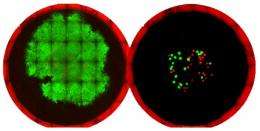In this experiment on standardised porous surfaces, a fast growing bacterial species (green) spreads and dominatethe surface if sufficient soil moisture is present. Under dry conditions both red and green bacretial species coexist and form only small colonies. (Photo: G. Wang / ETH Zurich)
The soil is the biosphere's most biologically active zone and harbours the largest reservoir of genetic diversity. In various disciplines, scientists – among them Dani Or's group – employ models of dynamic, aquatic soil micro-habitats with innovative experiments to try to solve the question of how this diversity originates and maintained.
Every Alpine valley has its own individual characteristics: language and dialect, architectural style, customs, food – and not least its own kind of people. Such regional differences are often found within astonishingly short distances. Romansch is spoken in one valley but in the next they speak German with a Valais accent.
Geographic isolation is one of the reasons for the occurrence of such cultural diversity. Dani Or, Professor at the Institute of Terrestrial Ecology, says that the valley communities were and are often isolated from one another for months at a time, especially in winter, which limits mobility and interchange. This geographic and weather-dependent isolation promotes the emergence of different “species” on a small landscape.
Parallels on soil particles
The ETH Zurich professor and his assistant Gang Wang also observed comparable processes on a much smaller scale in the soil when wet and dry conditions alternate cyclically. Zooming in, the surface of soil aggregates presents a picture on a micron scale strikingly similar to that on a large scale in the Alps: it is criss-crossed by valleys and mountain tops.
The valleys are populated by countless micro-organisms living under a wafer-thin film of water that allows them to move from one valley into the next, where they interact with bacteria of the same or different species and tap into nutrient sources with a partially patchy distribution. The “immigrants” compete with the “indigenous species” for the available nutrients. To move forwards efficiently, many soil bacteria have a flagellum which makes them highly motile in this water film.
Isolation in the absence of water
By using physical models, the researchers discovered that the thickness of the water film plays an essential part in the motility of the micro-organisms, especially when nutrients are distributed non-uniformly or patchily. A thin film of water also limits the spread of nutrients and makes life hard for all bacteria. Another relevant factor is that the thinner the water film, the higher its viscosity and capillary force, which literally pins the micro-organisms down onto the substrate. If the surface of the soil aggregates dries out, the bacteria can no longer utilise the motility given to them by the flagella.
Soil bacteria can now grow and proliferate only slowly under these conditions, and can spread out locally at most. If the water film breaks apart due to increasing substrate dryness, the microbial populations are then totally isolated from one another and are confined in their “valleys” with limited opportunities to mix with other micro-organisms. Or concludes that “Dry soil moisture regimes protect weak species and contribute to maintaining diversity in the soil.”
Thin water film impedes mobility
However, bacteria still find it worthwhile to form a flagellum which enable them to find nutirient rich niches and colonise new regions more quickly in times of increased soil moisture, e.g. in transitional situations between wet conditions and soil desiccation. The “benefits” derived from motilityoften compensate for the costs of the energy-intensive construction and maintenance of flagella. Or says “ability to move in such heterogeneous micro-environment explain why many bacteria form flagella even in partly water-saturated habitats such as on soil surfaces.”
To supplement their models, the researchers performed experiments using simplified standardised surfaces. Bacteria were cultured under a thin film of water on a porous ceramic surface, and the water film was controlled by means of a defined water tension. The results of the simulations and from these experiments largely concur with the models.
The diversity of species and genetic variants in the soil is many times greater than in the oceans. It is estimated that there are two million species of bacteria living in all the world’s seas. However, an estimated four million different bacteria species are present in one cubic metre of garden soil.
More information: Wang G, Or D: Aqueous films limit bacterial cell motility and colony expansion on partially saturated rough surfaces. Env. Microbiol. 2010. 12 (5), 1363-1373. dx.doi.org/10.1111/j.1462-2920.2010.02180.x
Dechesne A, Wang G, Gülez G, Or D, Smets BF: Hydration controlled bacterial motility and dispersal on surfaces, Proc. Nat. Acad. Sci. USA, 2010 107:14369-14372. dx.doi.org/10.1073/pnas.1008392107
Provided by ETH Zurich




















